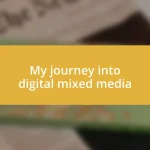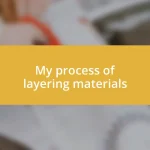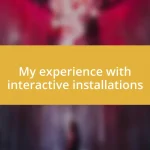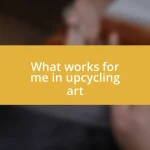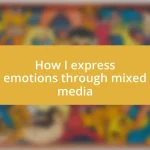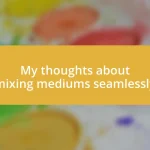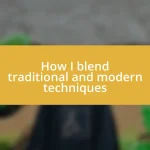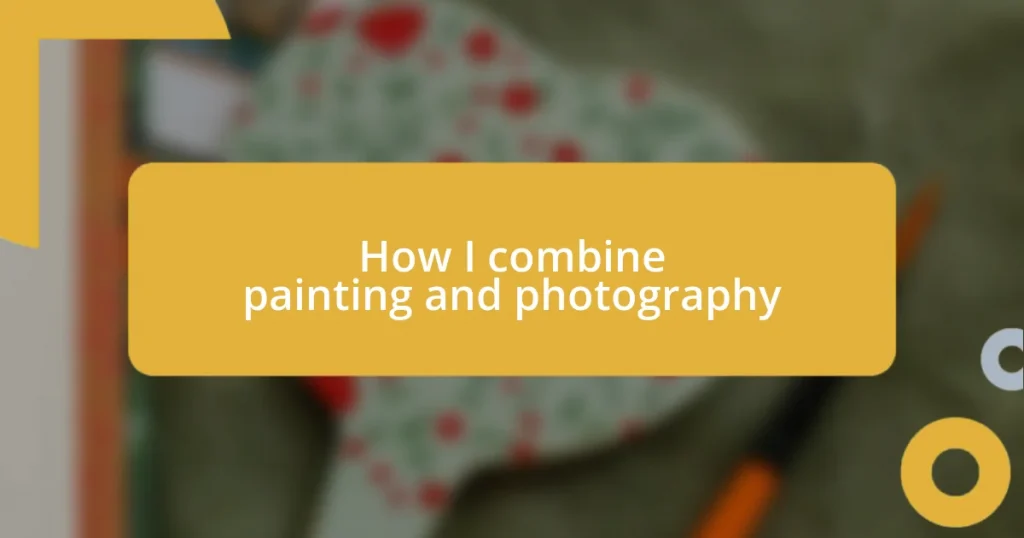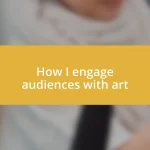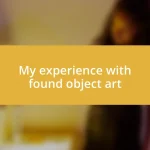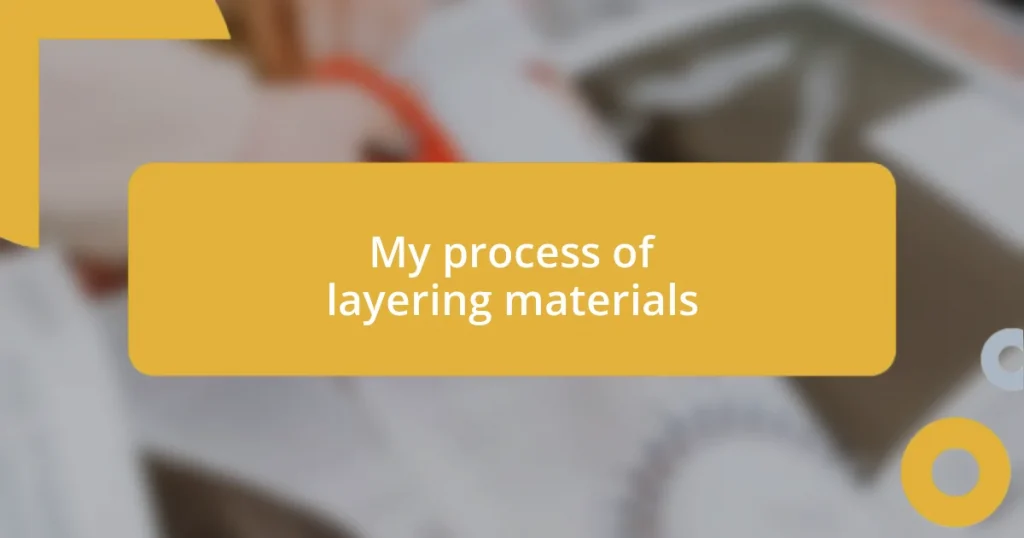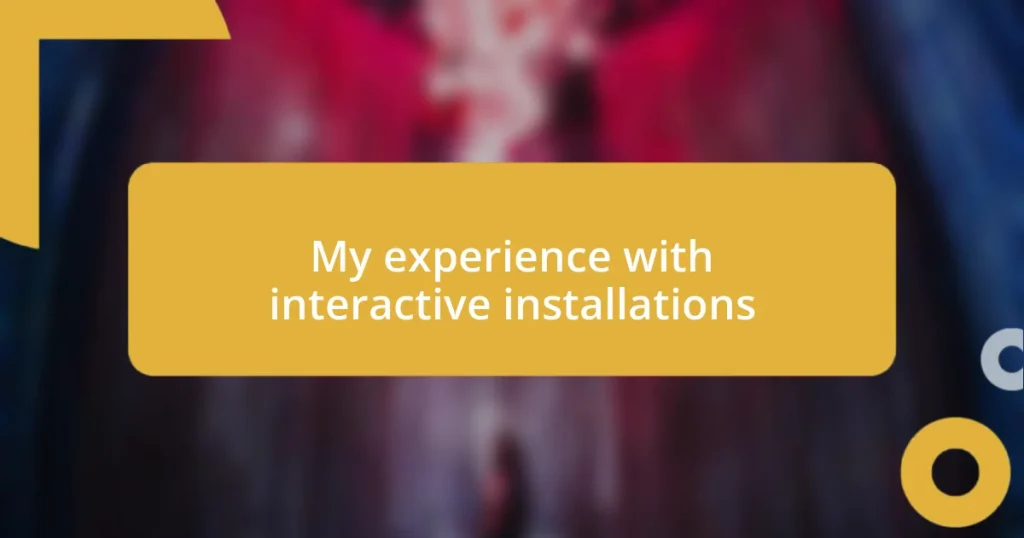Key takeaways:
- Painting allows for imaginative expression while photography captures raw reality; blending both can create deeper emotional narratives.
- Techniques like layering, textural manipulation, and incorporating personal elements help transform photographs into more immersive artworks.
- Establishing a dedicated workspace, maintaining a visual journal, and seeking feedback are essential practices for enhancing creativity in combined art forms.

Understanding Painting and Photography
Painting and photography, while distinct, share a symbiotic relationship that often inspires creativity in each medium. I remember the first time I picked up a camera after a long painting session — I felt this sudden urge to capture the world with the same brushstrokes I used on canvas. It made me wonder, can a photograph evoke the same emotion as a painting, or is there something inherently different about the two?
In my experience, painting allows for imagination to flow freely, while photography captures reality in all its rawness. When I photograph a scene, I often find myself thinking about how I would interpret it on canvas. Isn’t it fascinating how both art forms can convey a story, yet the narrative can change depending on the medium used?
Both arts serve as lenses through which we explore and express our perceptions of the world. Sometimes, I find myself blending techniques from each — using a photograph as a reference for a painting, layering emotion and memory onto the canvas. This fusion isn’t just a creative practice; it’s a fusion of what I love about both art forms. How do you see your own experiences reflected through these mediums?

Exploring Artistic Techniques
When I delve into the world of artistic techniques, one of the first things I notice is how painting can transform a simple photograph into something ethereal. I often take a photo and challenge myself to recreate its essence on canvas, focusing on light and shadow in a way that feels almost spiritual. This process allows me not just to replicate a scene, but to elevate it—bringing my emotions and thoughts into the strokes of paint. Isn’t it incredible how turning a moment captured in time into a layered masterpiece can evoke deeper feelings?
Another striking technique I enjoy is manipulating textures. I sometimes pour mediums into my photographs, transforming the digital image’s surface to mimic the tactile quality of paint. For example, a flat photo of a sunset can be altered with reflective materials, allowing the light to bounce off the paper similarly to how it would on an oil painting. I get a buzz creating these hybrid forms; it’s like blending two worlds into one cohesive experience. Have you ever thought about how textures can change the way we perceive art?
Through these techniques, I link the spontaneous nature of photography with the contemplative process of painting. This interplay not only enhances my artistic journey but also constantly reshapes my understanding of what art can be. It allows for an emotional dialogue between my brush and my lens, leading to new insights in both realms of creation.
| Technique | Description |
|---|---|
| Painting from Photographs | Transforming a photo to evoke emotion on canvas, focusing on light and shadow. |
| Textural Manipulation | Using reflective materials and mediums to create a tactile quality in photographs. |
| Hybrid Interplay | Combining elements of painting and photography for a richer, emotional experience. |

Combining Mediums for Unique Effects
When I begin to merge painting and photography, I often feel like an alchemist blending potions to create something entirely new. I remember a project where I started with a stark black-and-white photograph of a busy street. After applying layers of vibrant colors and expressive brushwork, the scene transformed into a lively representation of urban life, pulsating with energy and emotion. This experience taught me how combining these mediums can transcend mere representation; it’s about infusing art with my perspective, making it uniquely mine.
- Layering paint subtly over a photo can highlight personal emotions tied to the moment.
- Using bold brushstrokes can add drama, turning a calm landscape into something more dramatic and alive.
- Overlaying transparency allows for hidden details in photographs to emerge, creating layers of meaning and intrigue.
Shifting gears, I’ve also experimented with digital editing to blend watercolor effects into my photography, giving a dreamlike quality to images. One instance that stands out was after a serene trip to the mountains. I applied soft watercolor textures to my sky photos, evoking the tranquil feelings I experienced there. This practice reminds me of the interconnectedness of my emotional landscape and visual storytelling, suggesting that art can be a bridge between my inner world and the external one.

Enhancing Photos with Painting
When I paint over a photograph, it’s like having a conversation with the image. Recently, I worked on a photo of a friend laughing at a picnic. By adding vibrant colors and whimsical brush strokes, I found myself capturing not just her joy but also the warmth of that sunny day. Don’t you think that this kind of emotional infusion can breathe life into an otherwise static image?
Sometimes, I utilize a technique where I paint directly onto the print. This hands-on approach feels incredibly intimate. One time, I took a serene photo of a forest and layered cool blues and greens over the print. It transformed the piece into a more immersive experience, allowing me to share the calmness I felt while there. It’s fascinating how a simple brush stroke can enhance the viewer’s connection to a moment, don’t you think?
I’ve also discovered that adding elements like gold leaf can dramatically elevate a photograph’s narrative. I remember embellishing a sunset picture with shimmering accents, which turned the ordinary into the extraordinary. Those small touches can inspire viewers to pause and reflect, prompting them to explore the layers of meaning hidden beneath the surface. What stories might your own photos tell if you gave them a touch of artistry?

Developing a Personal Style
Developing a personal style is all about embracing the interplay between painting and photography. I vividly remember a piece where I started with a vibrant sunset photograph, but instead of leaving it as it was, I added gentle swipes of pastel hues. The final piece felt like a dream – it captured the essence of that magical evening while allowing my personality to shine through. It’s incredible how such small choices can completely transform an image, don’t you think?
In my journey, I’ve realized that experimentation is key to discovering a voice that truly reflects who I am. For example, there was this phase when I tried incorporating text into my artworks—my own handwritten poetry layered over a landscape photo. It added deeply personal narratives to the visuals, almost like a diary entry in paint and pixels. Each brushstroke felt like an extension of my thoughts, creating a dialogue between the viewer and my emotions.
I often ask myself, how can I push the boundaries of my style? When I took an abstract approach, overlaying random splashes of color onto a serene seascape photograph, I uncovered aspects of my artistic identity that I hadn’t recognized before. Those bold choices not only surprised me but also sparked conversations with friends about what art truly represents. It’s the process of self-exploration that ultimately leads to the development of a unique, personal style. What challenges are you facing in defining your artistic expression?

Practical Tips for Artists
When diving into the blend of painting and photography, I’ve found that setting up a dedicated workspace can make a world of difference. I remember one afternoon when I cleared my desk of distractions and surrounded myself with my favorite brushes and vibrant paints. The moment I did that, I felt an undeniable spark of creativity. Have you noticed how an organized and inspiring environment can elevate your artistic process?
Another practical tip is to keep a visual journal. I often jot down ideas or splash colors onto pages whenever inspiration hits. Recently, I found myself inspired by a stormy sky, so I experimented with different shades of gray and blue on paper before even touching a photo. This practice not only keeps my ideas flowing but also serves as a valuable reference for future projects. How often do you take time to explore your thoughts before committing them to canvas?
Finally, don’t shy away from seeking feedback. I remember sharing a painting combined with a photograph at an art group meetup, feeling a mix of excitement and nervousness. The insights I received helped refine my approach and offered perspectives I hadn’t considered. It’s intriguing how collaboration often unveils new layers of creativity that we might overlook. Are there people in your life who could challenge and inspire your artistic journey?

Showcasing Your Combined Artworks
When it comes to showcasing artworks that blend painting and photography, presentation is everything. I remember displaying a piece at a local gallery where I combined a striking black-and-white photograph with vibrant, swirling paint accents. The way I framed it—using a clean, modern frame—made the colors pop and drew the viewer in. Have you ever noticed how the right display can completely change the perception of your artwork?
Social media has become an amazing platform for sharing my combined creations. I often post time-lapse videos of my process, allowing followers to witness the transformation from a photograph to a finished painting. This engagement nurtures conversations that enhance my artistic journey. How do you use online platforms to connect with fellow artists and art enthusiasts?
I’ve also experimented with incorporating my combined works into products like prints and greeting cards. Seeing my artwork transformed into something tangible that others can cherish ignites a special joy within me. It’s fascinating how sharing my art in different formats not only broadens my audience but also deepens my connection to my own creations. Have you thought about how diversifying the way you showcase your art could open new doors for you?
